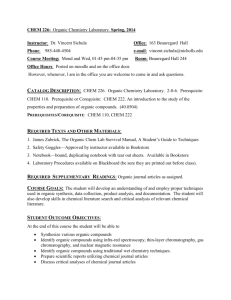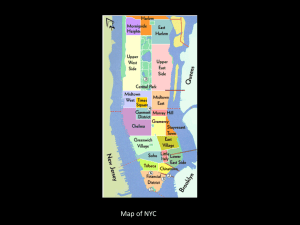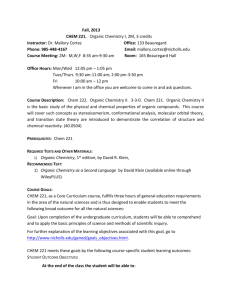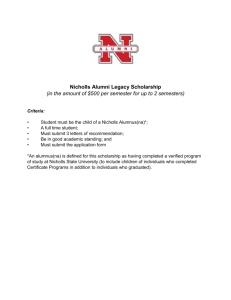CHEM 226: Organic Chemistry Laboratory. Spring, 2014 Instructor
advertisement
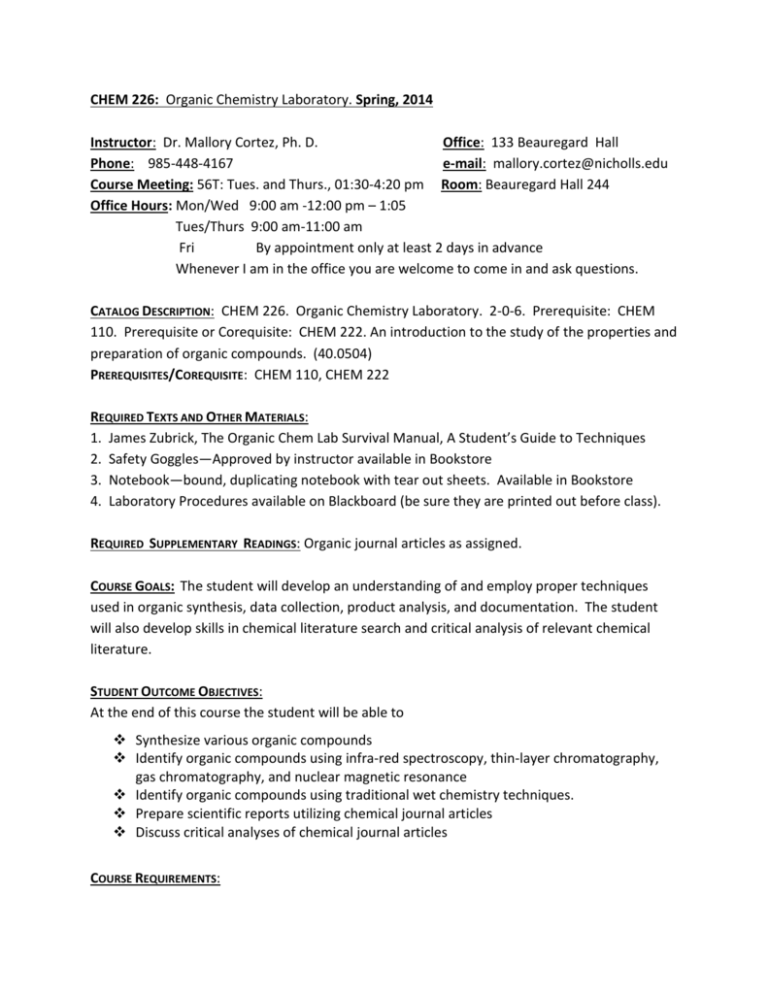
CHEM 226: Organic Chemistry Laboratory. Spring, 2014 Instructor: Dr. Mallory Cortez, Ph. D. Office: 133 Beauregard Hall Phone: 985-448-4167 e-mail: mallory.cortez@nicholls.edu Course Meeting: 56T: Tues. and Thurs., 01:30-4:20 pm Room: Beauregard Hall 244 Office Hours: Mon/Wed 9:00 am -12:00 pm – 1:05 Tues/Thurs 9:00 am-11:00 am Fri By appointment only at least 2 days in advance Whenever I am in the office you are welcome to come in and ask questions. CATALOG DESCRIPTION: CHEM 226. Organic Chemistry Laboratory. 2-0-6. Prerequisite: CHEM 110. Prerequisite or Corequisite: CHEM 222. An introduction to the study of the properties and preparation of organic compounds. (40.0504) PREREQUISITES/COREQUISITE: CHEM 110, CHEM 222 REQUIRED TEXTS AND OTHER MATERIALS: 1. James Zubrick, The Organic Chem Lab Survival Manual, A Student’s Guide to Techniques 2. Safety Goggles—Approved by instructor available in Bookstore 3. Notebook—bound, duplicating notebook with tear out sheets. Available in Bookstore 4. Laboratory Procedures available on Blackboard (be sure they are printed out before class). REQUIRED SUPPLEMENTARY READINGS: Organic journal articles as assigned. COURSE GOALS: The student will develop an understanding of and employ proper techniques used in organic synthesis, data collection, product analysis, and documentation. The student will also develop skills in chemical literature search and critical analysis of relevant chemical literature. STUDENT OUTCOME OBJECTIVES: At the end of this course the student will be able to Synthesize various organic compounds Identify organic compounds using infra-red spectroscopy, thin-layer chromatography, gas chromatography, and nuclear magnetic resonance Identify organic compounds using traditional wet chemistry techniques. Prepare scientific reports utilizing chemical journal articles Discuss critical analyses of chemical journal articles COURSE REQUIREMENTS: Students will perform all experiments using proper safety practices. Prelabs: 5 points/experiment Lab Report: 10 points/experiment Post Labs Questions: 5 points/experiment 13 experiments Formal report: 50 points Experiment#9 Midterm Exam: Lit Review Presentation: 1H NMR, 13C NMR and IR assignment Total Points 260 points 50 points 100 points 50 points 50 points 510 points Pre LAB Question. The purpose of prelabs is to prepare you for the experiment. Make sure you read and understand the lab. I will post the prelab questions ahead of time before the experiment. POST LAB QUESTIONS: I will post the postlab questions on moodle. The purpose of postlab questions is to see whether you understood the techniques you performed during the experiment. LAB REPORT: Every experiment you will perform has to be reported in your laboratory notebook as a lab report. The lab report will be due one week after the experiment. Please see the details below under NOTEBOOK to see how to write a lab report. FORMAL REPORT : You will write a formal report on Biosynthesis of Ethanol from Molasses experiment#09. This report should be written in the form of a scientific journal. Details on how to write a formal report will be discussed. MIDTERM EXAM: You will have a midterm exam on 10/14/2013. The midterm exam will cover all the materials you have learned up to this time. 1H NMR, 13C NMR and IR assignment: This is a take home assignment. Literature Review Presentation: No more than 10 slides, the students will give a 10-15 minute presentation on a current scientific journal article pertaining to chemistry. We will discuss literature searches and choosing an interesting article in class. METHOD OF EVALUATION: A straight percentage is used to determine grade. 90%-100% A 80%-89% B 65%-79% C 55%-64% D NOTEBOOK Notebooks must be written legibly to avoid loss of points. I want all parts listed below in all lab reports unless otherwise noted. TITLE DATE PURPOSE: Describe what is expected of the laboratory. This should be only one or two sentences, in your own words--do not copy from the manuals. THEORY: Summarize the theory about the experiment PROCEDURE: Read the lab and be familiar with what will be happening. After the experiment describe how you carried out the experiment briefly in your own words. DATA TABLE: Listing of all of the reagents and solvents used in the experiment. List in table form only. reagent or product CHEMICAL molecular weight EQUATIONS: mass used or produced moles used or produced melting point boiling point density solubility in solvents used. Write all of the major chemical reactions and side reactions for the experiment. OBSERVATIONS: All data and everything that occurs in lab as it happens. Colors, smells, amounts used, mixing, temperatures, apparatus used, time for reaction, spills if they occur etc. Draw pictures if appropriate, use tables, graphs, equations, etc. Record details such as Instrument name and make, model number and serial number, chemical manufacturer, grade, lot number, expiration date, etc. CALCULATIONS: Theoretical yield and percent yield. You must show all the calculations. CONCLUSION: Write the final conclusion Safety: Safety in this class is very important, and as such, you will be required to wear safety goggles at all times. Failure to wear the safety goggles will result in up to 20 points subtracted from your lab reports per day. Reminding you twice in a lab period will result in a loss of 5 points, 3 reminders will result in a loss of 10 pts, and 4 reminders will result in your removal from the class and a 0 on your lab report. MAKE-UP POLICY: No make-ups are allowed for the experimental or discussion portion of the class. Late laboratory reports will be deducted 5 points per day (including weekends). ACADEMIC HONESTY POLICY: Any student found cheating, including plagiarism, will be subject to the penalties as stated in the Student Code of Conduct handbook; including but not limited to a score of zero on exam, review or report, expulsion from the class or expulsion from the University. ATTENDANCE POLICY: Attendance is mandatory. This is a laboratory class. You must be present to complete the requirements. The sign in sheet will be available at the beginning of the class and it is your responsibility to sign your name to show that you attended the lab. For every un-excused absence, your grade will drop by one letter. If you miss a laboratory with an excused absence, you will still have to submit the lab report by getting the data from your lab partners and understanding the experiment. SEMESTER WITHDRAWALS: The last day to withdraw from the class with a “W” is March 28th 2014. ACADEMIC DISABILITIES POLICY: If you have a documented disability that requires assistance, you will need to register with the Office of Disability Services for coordination of your academic accommodations. The Office of Disability Services is located in Peltier Hall, Room 100-A. The phone number is (985) 448-4430 (TDD 449-7002). ACADEMIC GRIEVANCES. The proper procedure for filing grade appeals or grievances related to academic matters is listed in Section 5 of the Code of Student Conduct and at he following link: http://www.nicholls.edu/documents/student_life/code_of_conduct.pdf . ASSISTANCE WITH STUDYING AND ASSIGMENTS The Tutoring Center at 143 Peltier Hall. Call 985-448-4100, email: tutoring@nicholls.edu, or visit http://www.nicholls.edu/academic-enhancement/ The Writing Center at 144 Peltier Hall. Call 985-448-4100, email: tutoring@nicholls.edu, or visit http://www.nicholls.edu/academic-enhancement/ Online Tutoring through Moodle. Look for the Brainfuse log-in link on the home page,http://moodle2.nicholls.edu/moodle/ CONTINUED LEARNING FOLLOWING AN EXTREME EMERGENCY: In order to make continued learning possible following an extreme emergency, students are responsible for: Reading regular emergency notifications on the NSU website; Knowing how to use and access Blackboard/moodle; Being familiar with emergency guidelines; Evacuating textbooks and other course materials; Knowing their moodle student login and password; Contacting faculty regarding their intentions for completing the course. Faculty are responsible for: The development in the use of the moodle software; Having a plan for continuing their courses using only Blackboard and email; Continuing their course in whatever way suits the completion of the course best, and being creative in the continuation of these courses; Making adjustments or compensations to a student’s progress in special programs with labs, clinical sequences or the like only in the immediate semester following the emergency. Note: This is not a binding contract. This syllabus is subject to change throughout the course. CLASS DISRUPTIONS: The use of cellular phones, pagers or any other electronic personal devices is prohibited in class. Any infractions will result in class being dismissed and experiments considered over. This includes but not limited to using your phone as timer—get a watch or I will supply stopwatches if needed, going to the hallway while a experiment is ongoing to check on texts. texting or calling or receiving incoming calls or texts receiving alerts regarding incoming texts or calls using phone as alarm system. Note: This is not a binding contract. This syllabus is subject to change throughout the course. Tentative Schedule Day 01/23 Experiment General Information Check In/Safety 01/28 Melting Point Determination (Manual: Ch. 12) Experiment # 1 01/30 Purifying Acetanilide by Recrystallization (Manual: Ch. 13) Experiment# 2 02/04 Synthesis and Characterization of Aspirin (Klein Ch. 21.9) Experiment# 3 02/06 Synthesis and Characterization of Aspirin (Klein Ch. 21.9) Experiment# 3, cont part 2 02/11 Extracting Caffeine from Tea leaves (info. On alkaloids: Experiment# 4 Klein Ch. 23.1; info. Manual about Extractions: Ch. 15) 02/13 Greener Bromination of E-Stilbene (Klein Ch. 9.8) Experiment# 5 02/18 Dehydration of cyclohexanol (Klein, Ch. 8 and Ch. 13.9 E1 Experiment# 6 and E2 reactions) 02/20 Friedel-Crafts Acetylation of Ferrocene (Klein Ch. 19.6) Experiment# 7 02/25 Friedel-Crafts Acetylation of Ferrocene (Klein Ch. 19.6) Experiment# 7, cont. 02/27 Lecture on IR ( Infrared spectroscopy) (Klein Ch. 15) 03/04 Mardi Gras Holiday 03/06 Lecture on IR ( Infrared spectroscopy) (Klein Ch. 15) and EAS 03/11 Electrophilic Aromatic Iodination of Vanilline (Klein Ch. 19) 03/13 Review of Midterm Exam 03/18 Midterm Exam 03/20 Start experiment: Biosynthesis of Ethanol from Molasses Lecture on NMR 1H, 13 C (Klein Ch. 16) Start experiment: Solid-Phase Photochemistry ([2+2] cycloaddition, Klein Ch. 17.8) Lecture on NMR 1H, 13 C (Klein Ch. 16) Lecture on NMR 1H, 13 C (Klein Ch. 16) IR/NMR Assignment Assigned Solid-Phase Photochemistry: Rotate the flask / Exp #10 Continue: Biosynthesis of ethanol experiment 03/25 03/27 04/01 Experiment# 8 Experiment# 9 Experiment# 10 IR and NMR assignment Experiment# 10 04/03 Set up: Biodiesel Experiment Experiment# 11 04/08 Finish: Solid-Phase Photochemistry. Workup and Experiment# 9 purification Experiment Experiment # 11 Finish: Biodiesel experiment: Analyzing IR of Biodiesel 04/10 A: Reductions Reactions of 3-Nitroacetophenone Tin and Experiment# 12 HCl (Klein Ch. 23.4) 04/15 Experiment B: Reductions Reactions of 3- Experiment# 13 Nitroacetophenone NaBH4 (Klein Ch. 13.4) 04/17 IR Lab: Analyzing the Products of experiments A and B Experiment# 12 and 13 IR/NMR assignment Due NMR/IR Assignment due Ex. Lit review Presentation by Dr. Cortez 04/22 Spring Break No Class 04/24 Spring Break No Class 04/29 Nylon and Check Out Experiment # 14 05/01 Literature Presentations Formal Report Due 05/06 Last Class : Literature Presentations
